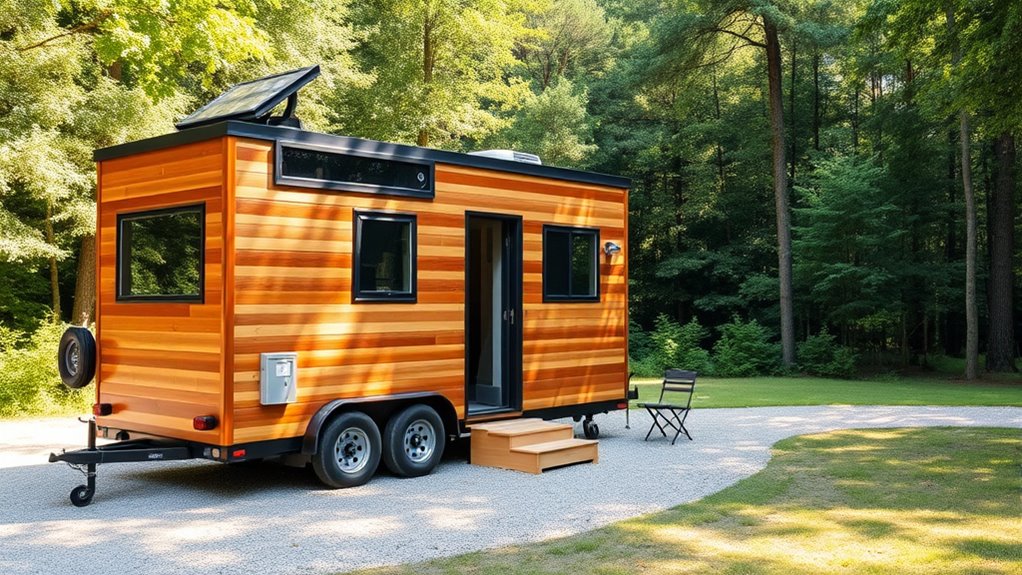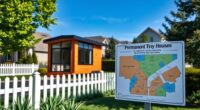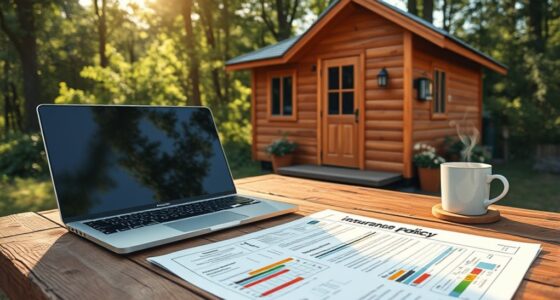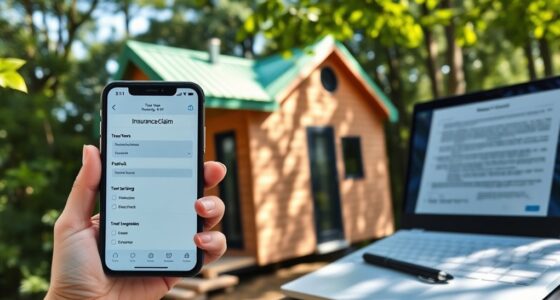Before insuring your mobile tiny home, you should understand that it needs specialized coverage tailored for wheel-equipped homes, protecting against risks like fire, theft, weather damage, and vandalism. Make certain your policy covers both the structure and personal belongings, including custom modifications. Check if transportation and storage are included, and compare providers for coverage options and limits. To make sure you’re fully protected, there’s more to consider—keep exploring to learn how to get the right coverage for your tiny home.
Key Takeaways
- Ensure the policy covers both the tiny home’s structure and personal belongings adequately.
- Confirm if transportation and storage during moves are included in the coverage.
- Check liability limits to protect against guest injuries or property damage.
- Compare policies for specialized tiny home coverage, including custom modifications.
- Review policy details for exclusions, deductibles, and coverage limits to avoid surprises.
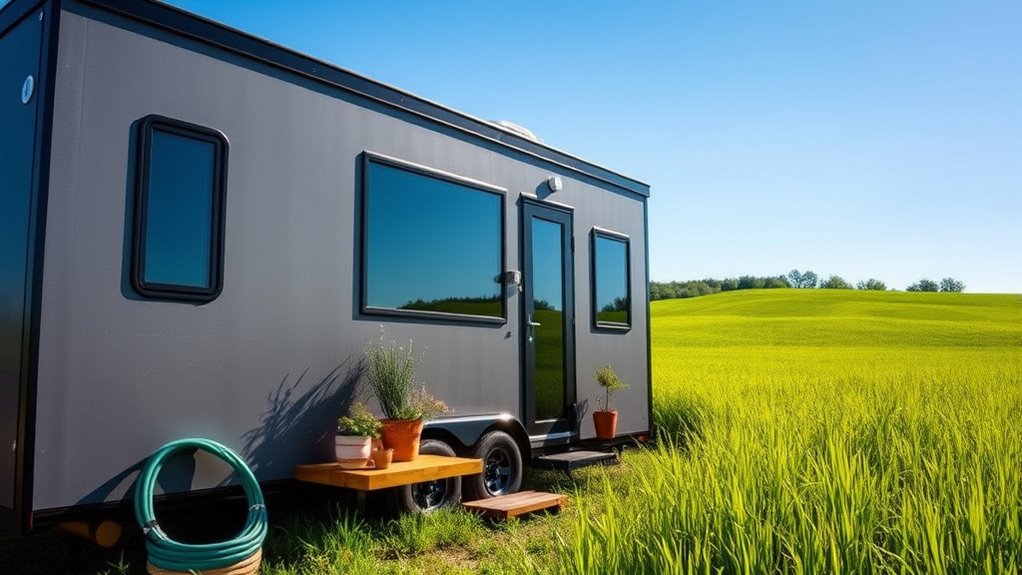
Have you considered how to protect your mobile tiny home from unexpected events? It’s a essential step in ensuring your investment remains secure, especially given the unique nature of tiny homes on wheels. When exploring your insurance options, understanding mobile home coverage becomes necessary. Unlike traditional homeowners insurance, mobile home coverage is tailored specifically for homes that are mobile, often providing protection against common risks like fire, theft, vandalism, and weather damage. You’ll want to verify that the policy covers not only the structure itself but also your personal belongings inside. Since tiny homes are compact and often customized, check whether the coverage matches the value of your furnishings, appliances, and other essentials, and whether it accounts for any custom modifications you’ve made.
Protect your tiny home with tailored mobile home insurance covering structure, belongings, and custom modifications.
Liability considerations are equally important. As the owner of a mobile tiny home, you could be held responsible if someone is injured on your property or if your home causes damage to neighboring properties or public areas. Liability coverage protects you financially in such situations, covering legal fees, medical expenses, and damages awarded in lawsuits. It’s easy to overlook this aspect, but it’s important because accidents happen unexpectedly. For example, if a visitor trips on your steps or if your home rolls slightly during transport and causes damage, liability coverage helps shield you from potentially significant costs. When selecting a policy, review what liability limits are included and consider increasing them if you often host guests or plan to move your tiny home frequently.
You should also consider whether your insurer offers coverage for transport and storage. Many tiny home owners move their homes regularly, so understanding how your policy handles these situations can prevent gaps in protection. Some policies might exclude coverage during transportation, leaving you vulnerable during moves. Additionally, ask about coverage during storage, especially if your tiny home is parked in a different location for an extended period. Clarifying these details helps avoid surprises later on.
Lastly, don’t forget to compare quotes from multiple providers and read the fine print. Each insurer has different policies, and some may offer specialized coverage for tiny homes. Be thorough in assessing what’s included, such as coverage limits, deductibles, and exclusions. By paying close attention to mobile home coverage options and liability considerations, you’ll better position yourself to protect your tiny home investment and enjoy peace of mind on your journey.
Frequently Asked Questions
How Does Location Affect Tiny Home Insurance Costs?
Your location considerably impacts tiny home insurance costs due to regional risks and location variability. If you’re in an area prone to natural disasters like floods or hurricanes, your premiums will likely be higher. Urban areas might have higher theft or vandalism risks, increasing costs as well. Understanding these regional risks helps you better anticipate insurance expenses and choose coverage that suits your tiny home’s specific location.
Are There Coverage Options for Natural Disasters Specific to Tiny Homes?
Think of your tiny home as a delicate boat steering unpredictable waters. Yes, there are natural disaster coverage options designed specifically for tiny homes, helping you stay afloat during storms, floods, or wildfires. Tiny home safety is a priority, and insurance policies often include protection against natural disasters. Make sure to ask your insurer about these options so you’re prepared for any sudden squall that comes your way.
Can I Insure My Tiny Home for Business Use?
Yes, you can guarantee your tiny home for business use with specialized Mobile home or Tiny home insurance policies. These policies often cover damage, liability, and equipment loss related to your business activities. Make sure to discuss your business plans with your insurer to get the right coverage. Insuring your tiny home for business use helps protect your investment and ensures you’re covered if unexpected events occur during work.
What Safety Features Can Lower My Insurance Premiums?
Think of your tiny home as a fortress; adding safety features makes it stronger. Installing security systems and safety technology, like smoke detectors and fire extinguishers, can considerably lower your insurance premiums. These upgrades act like a shield, protecting your home from potential risks. By investing in these safety features, you not only secure your space but also enjoy more affordable insurance, giving you peace of mind on your tiny home journey.
How Does Personal Property Coverage Work in Tiny Home Insurance?
Personal property coverage in tiny home insurance protects your belongings from risks like theft, fire, or storms. You’ll choose coverage limits based on the value of your possessions. If a covered event occurs, the insurer helps replace or repair your personal property up to those limits. Make sure your coverage limits align with the value of your belongings to avoid gaps in protection, and consider adding extra coverage for high-value items.
Conclusion
Insuring your mobile tiny home might seem simple, but it’s anything but boring. While the process offers peace of mind, the coverage options can be complex and surprising—much like the tiny space itself. Don’t overlook the details, or you might find yourself wishing for more protection when life throws a curveball. Embrace the challenge, and you’ll enjoy the freedom of knowing you’re truly covered, no matter how small your home or big the unexpected.
